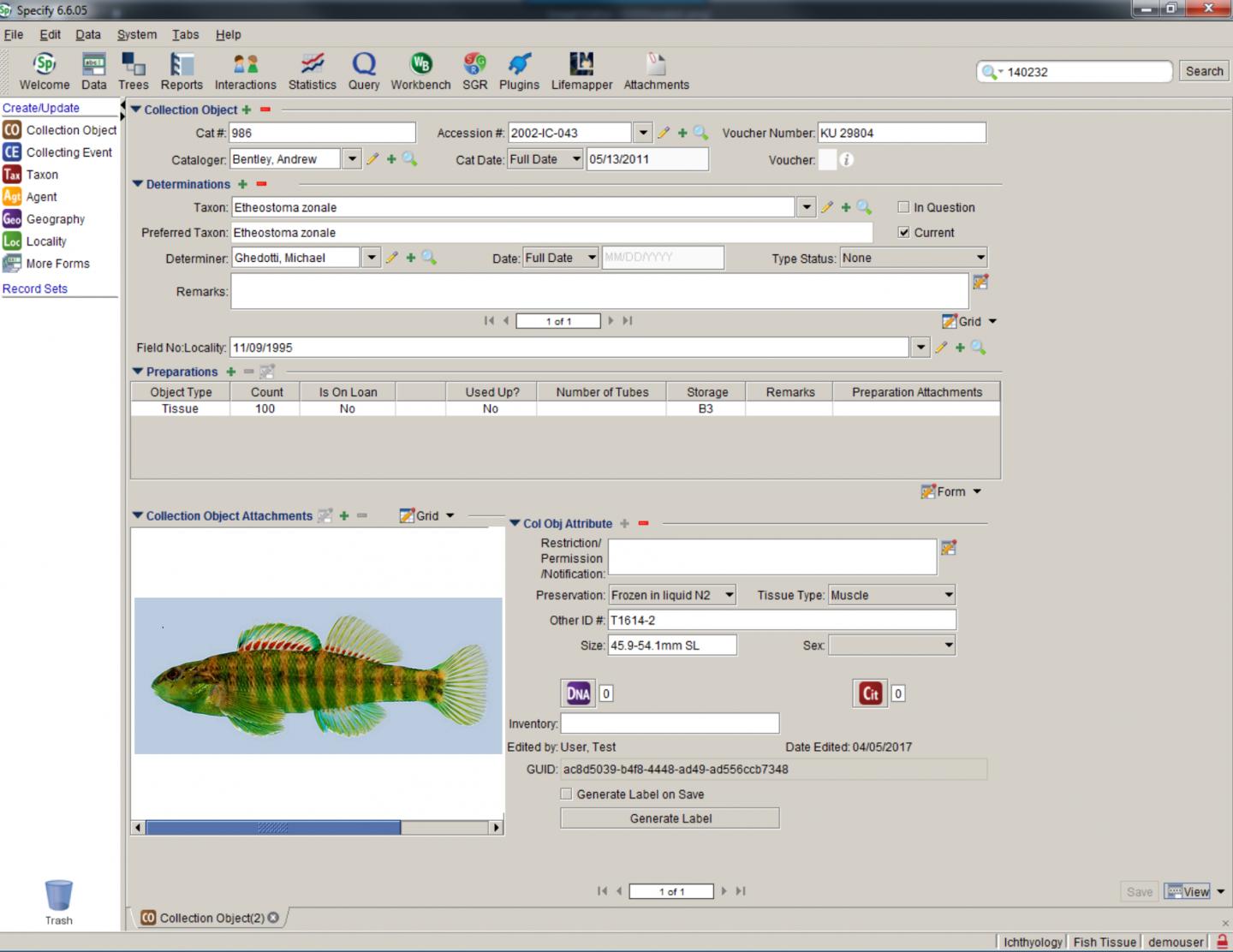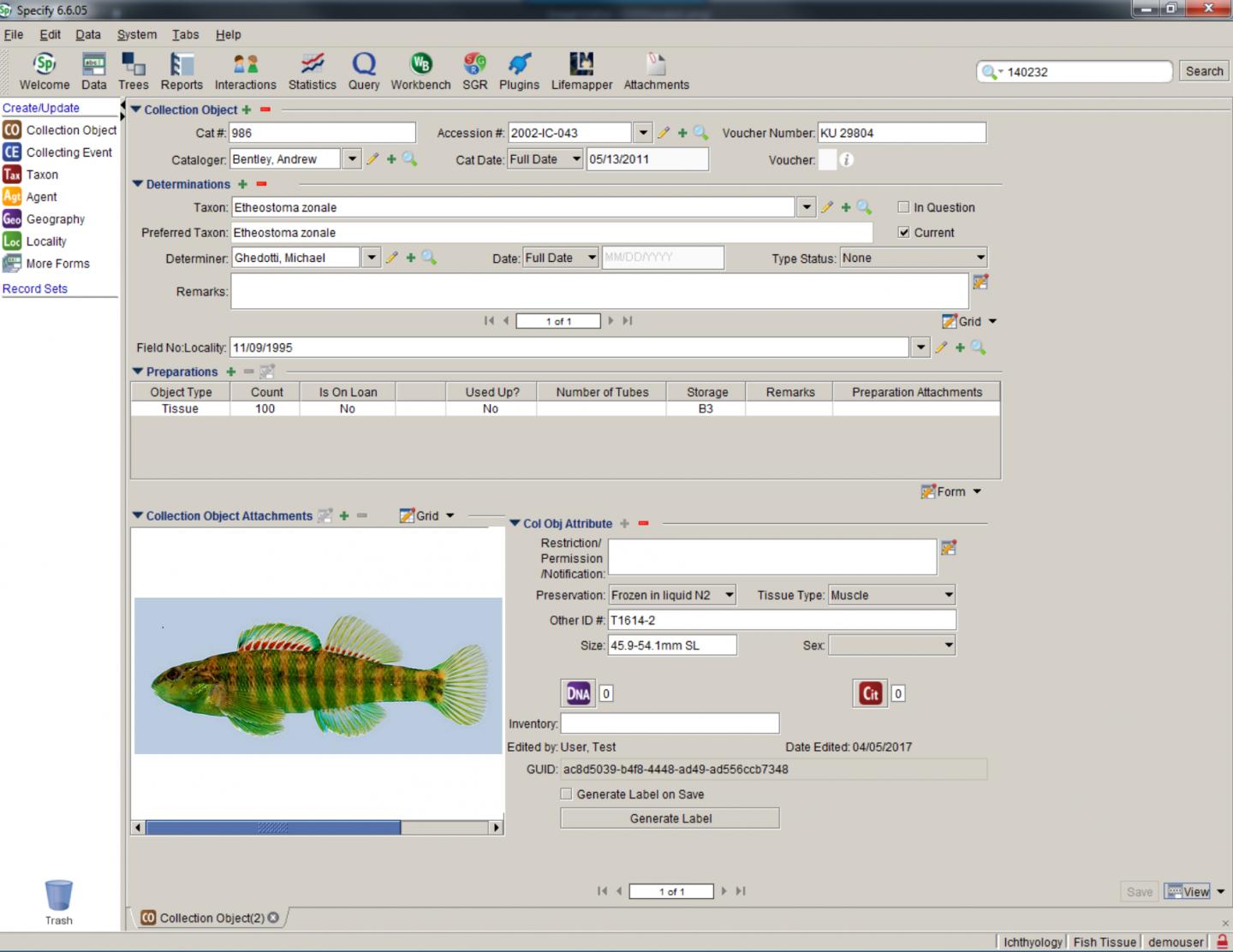
Credit: University of Kansas
LAWRENCE — For more than 20 years, scientists managing biological research collections around the world have used open-source Specify software for data entry, managing museum curation, linking images and documents to specimens, and for sharing species information for education and research. Recently, the project has added options for mobile and cloud-computing technology.
"We're a lot like a small nonprofit software company," said James Beach, assistant director for informatics at the University of Kansas' Biodiversity Institute and Natural History Museum, who heads up the Specify team.
As of 2018, 500-plus collections in 38 countries use the Specify database platform, which was developed at the institute, and where the Specify team is headquartered today. Indeed, a large slice of the world's scientific catalog of biodiversity specimens is managed with Specify software.
"There are billions of animals and plants in the world's collections, and each specimen documents an occurrence of a particular species at a particular time and place," said Beach. "The original reason these collections were made was to identify, name and classify new species. Today, with data from the same specimens, we can create historical maps about species distribution, current day ranges and future projections of where species are likely to survive given climate change and other man-made environmental disturbances."
Over the life of the Specify project, the National Science Foundation has funded the endeavor to the tune of about $400,000 per year. These resources, and additional funding from KU, have funded a team of two full-time programmers, a help desk manager, a trainer, a director and two or three part-time student employees.
But recently, given its demonstrated viability as a widely used platform, the NSF encouraged Specify to seek a broader revenue model to show museum community buy-in.
"We're like the 20-year-old still living in the basement of the parents' house, and NSF told us to 'come out and get a life,'" said Beach. "So, about a year and a half ago, we started doing research on sustainable organizational models to migrate Specify from grant-supported to a community- supported effort. We interviewed project directors over the phone, from libraries, archives and other open-source efforts around the country and also received some organizational development advice from other nonprofits. We compiled a bunch of ideas, feedback and advice about the options."
After extensive research and consultation on the ideal way to reorganize Specify, Beach and his colleagues at KU and partner institutions landed on the idea of a biological museum-membership organization.
"The way that seemed the most sustainable was a membership organization where a consortium of museums would pool resources with a common vision of advancing research informatics for the data associated with their specimen holdings," Beach said. "Part of our vision was to create an organization that would attract institutions of all sizes — state institutions, smaller institutions, government agencies and institutions overseas."
Under the new model, the KU researcher said larger organizations would contribute a larger share of the operating budget, while smaller ones would pay membership dues according to their abilities for service and support. Specify software itself will remain open source licensed and free for anyone to use.
"We have very many collaborating institutions with very limited operations budgets," Beach said. "We didn't want to start charging for software under a commercial license for this research community and thereby leave large numbers of museums without any cataloging software options. So, anybody can use the software without cost, and institutions that are better resourced contribute a bit more than their proportional share to subsidize overall activities. It takes a lot of vision on the part of these larger institutions, because they could use the software for free. But their directors, including Kris Krishtalka here at the KU Biodiversity Institute, appreciate the value of open-source software initiatives and publishing their data on the internet."
Along with KU, founding members of the new consortium consolidating around Specify include the University of Florida and the University of Michigan. Each has made an annual investment of at least $40,000. Other, smaller institutions already have joined on a sliding scale that goes down to as little as $1,000. With more institutions pending, Beach was cautiously optimistic that the new model of financing could replace NSF money on which the effort has long depended.
"There's still some uncertainty before our grant funding runs out this fall," he said. "We could go back to NSF to appeal for some temporary bridge funding if there's a crisis. But we're trying to obtain sufficient commitments before mid-July to make a decision about whether the model we have is viable or not. First, we're trying to raise enough revenue to maintain current staff level — you can never have too many software programmers. Instead of two of them, we'd love to have five or ten."
Beach said the blueprint for the consortium model came from examining other disciplines at KU, where private companies often join forces with research efforts in the School of Engineering or School of Business, for example.
"We looked around for models to see how other community engagement efforts work, and we learned from the KU provost that there's already a model for this at KU," he said. "Some KU engineering centers and programs in the KU School of Business have industry affiliate programs, or IAPs. They get corporations to join as members on an annual basis to create an organization based on a member agreement KU has sanctioned. Businesses see it as a benefit because they meet students, talk about research and keep in touch with what's going on in the lab. Often, those students become recruits once they graduate. But nothing like this has ever been done in biology, and as we examined that option we were delighted that this path seemed to have green lights as far as we could see."
But instead of corporations, the partners in the Specify IAP will be other research museums that will use Specify software and who will collaborate by making software code contributions. In a similar way to the IAPs in engineering, the Specify Consortium will continue train students in biodiversity informatics in large part through technical interactions with museums around the world.
"Museums will get the same access to our technical expertise as before," said Beach. "We'll design and evolve research software, and they'll have access to our lab to inform us of new science requirements. We'll meet with our partners and have an advisory committee — but there's no profit motive. It's a really terrific way to do academic engagement and outreach under the auspices of KU with a proven research organizational model."
###
Biological collections institutions with interest in the consortium forming around Specify should contact Beach at [email protected].
Media Contact
Brendan M. Lynch
[email protected]
785-864-8855
@KUNews
http://www.news.ku.edu
Original Source
https://news.ku.edu/2018/05/22/group-making-digital-tool-documenting-life-earth-adopts-new-organizational-model






